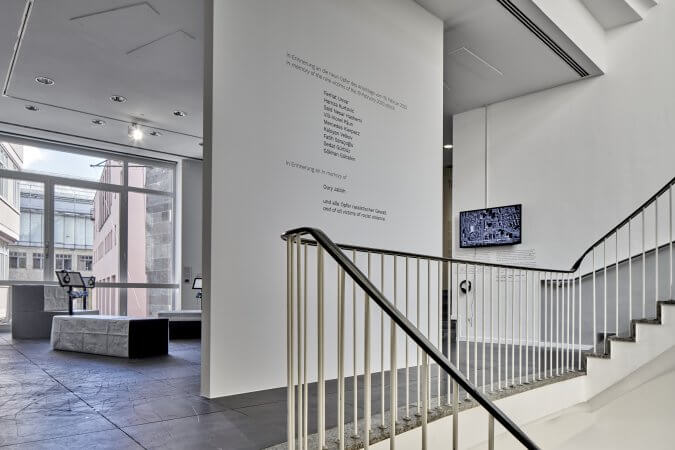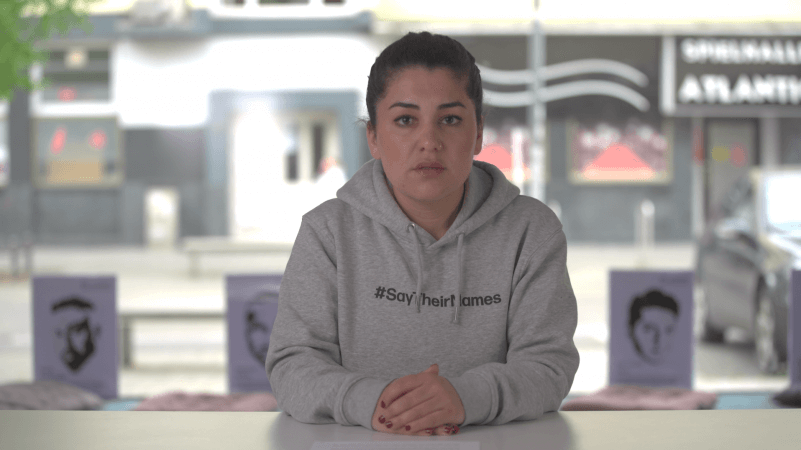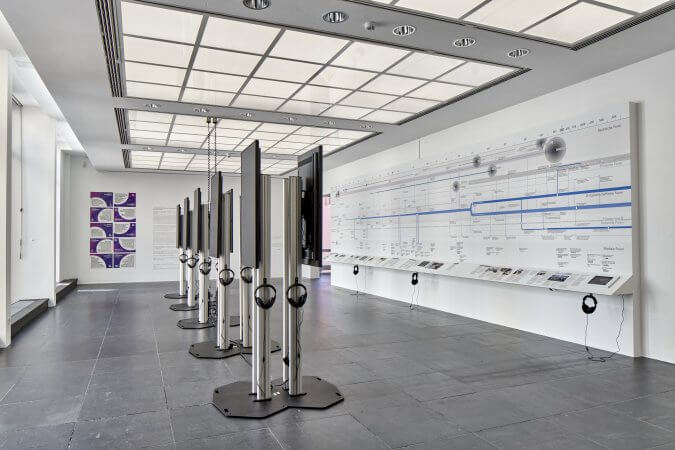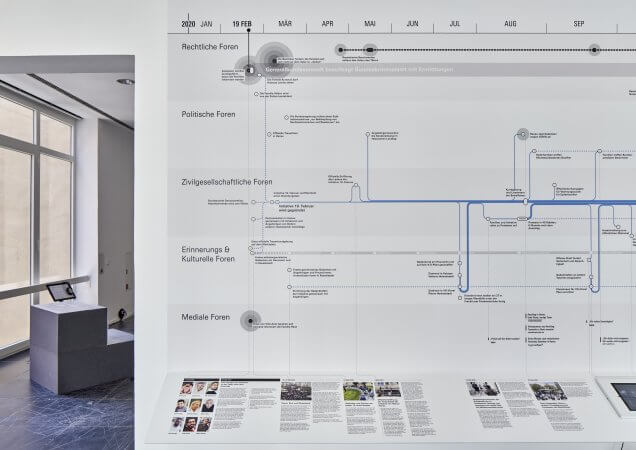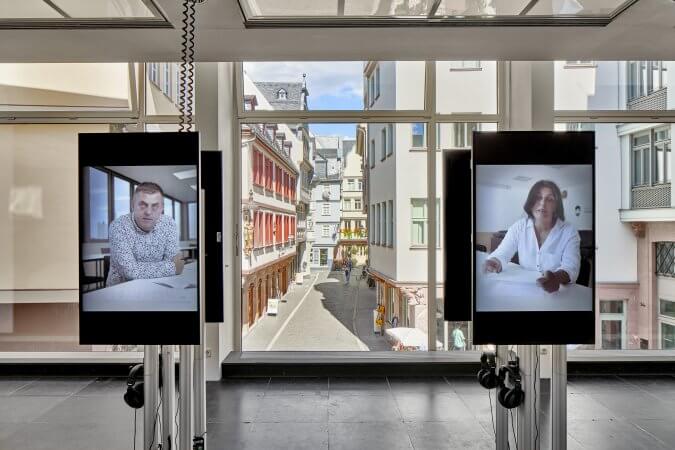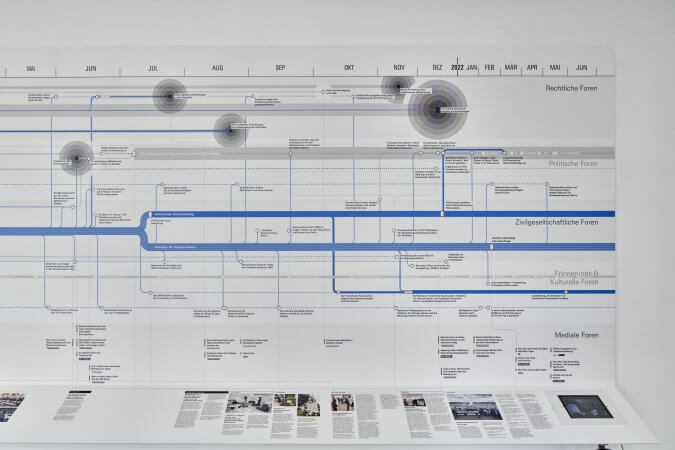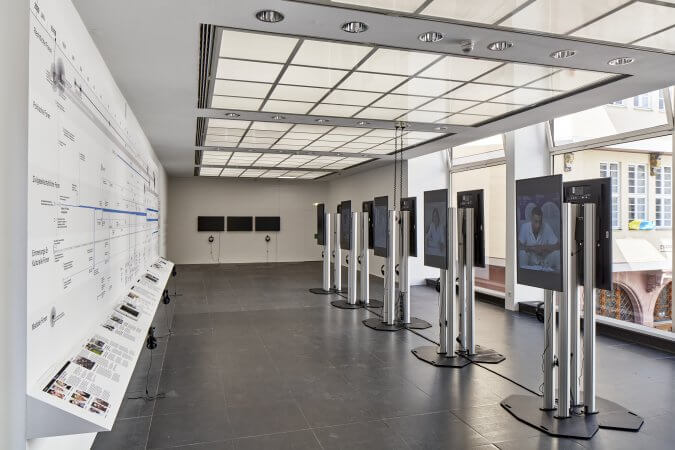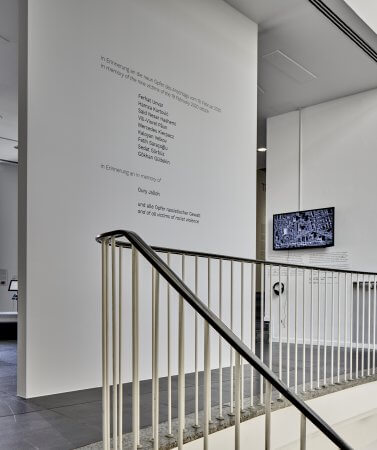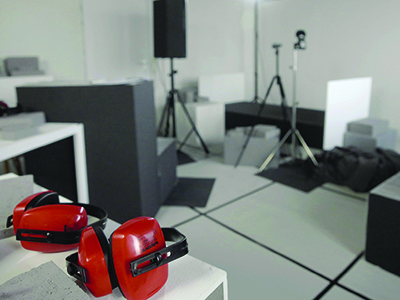Space dedicated to the Initiative 19. Februar Hanau
VIDEO “INVITATION”
Credit: Initiative 19. Februar Hanau, Forensic Architecture/Forensis, 2022
In the days and months following the attack in Hanau, a solidarity movement grew to support the bereaved families and survivors. By May 2020, the Initiative 19. Februar Hanau had opened its social centre on Heumarkt, directly opposite the first attack site. There, four central demands were soon formulated together with all those affected: Remembrance, Clarification, Justice, and Accountability.
In the summer of 2021, the Initiative 19. Februar Hanau contacted Forensic Architecture/Forensis for the first time. Together with the victims’ families and their lawyers, they commissioned the independent investigative agencies to examine some important, open questions regarding the official procedures and police operation on the night of the attack.
A TIMELINE OF COLLECTIVE ACTION
The mural A Timeline of Collective Action tells the story of two years of struggle for remembrance, clarification, justice, and consequences by the families of the victims, the survivors of the attack, and their allies and supporters in the Initiative 19. Februar Hanau and elsewhere.
Commonly, when a crime is committed, police secure the crime scene and control the investigation. Such is the process of state forensics. But when the state or the police becomes entangled with a criminal act, they fail to prevent it, or have made serious errors, the process of forensics is disrupted, and as a result, justice for the victims is often not delivered.
In such cases, it becomes necessary for civil society to ‘take over the means of evidence production’, to conduct independent investigations and utilise its own resources and opportunities to apply pressure. This mural records how the victims’ families and the Initiative engaged new partners and asserted their demands across multiple forums: legal, political, and cultural spaces, civil society, and the media.
This response by civil society – of which this exhibition is part – is open-ended, incomplete, and evolving. It seeks to bring new publics into conversation with the situated experience, embodied knowledge, commitment, and perseverance of racialised communities, and to put innovative investigative techniques in the hands of those communities and their supporters. We call this process ‘counter-forensics’.
TESTIMONIES OF THE RELATIVES AND SURVIVORS ABOUT THE NIGHT OF THE CRIME IN HANAU AND ITS CONSEQUENCES
The Initiative 19. Februar Hanau has documented in ten videos the testimonies of the relatives and survivors given to the investigative committee of the Hessian State Parliament.
As early as the summer of 2020, the families and their supporters had demanded a parliamentary committee of enquiry. At the time, even well-meaning party representatives were skeptical about the campaign’s chances of success because there was too little evidence of failure on the part of the authorities. Continuous demands, public pressure and persistent protests on the part of the families led one year later, on 7 July 2021 in Wiesbaden, to all parliamentary groups, except for the AfD, voting for the establishment of the Hanau investigation committee (UNA). Also Interior Minister Beuth had to pledge his support.
The ten central issues for the UNA were worked out by the Hessian SPD in close consultation with the families, lawyers and the Initiative 19. Februar Hanau. In the face of resistance from the government coalition, the relatives were the first to be heard – unprecedented in the history of investigation committees.
At the first four public hearings on 3 December, 17 December, 20 December 2021 and 21 January 2022, Vaska Zlateva, Hayrettin Saraçoğlu, Emis Gürbüz, Niculescu Păun, Etris Hashemi, Armin Kurtović, Cetin Gültekin and Serpil Temiz Unvar (among others) gave their testimony. Their accounts, as well as those of Valentino Juliano Kierpacz, the son of Mercedes Kierpacz, and the survivors Piter Minnemann and Muhammed Beyazkendir, were recorded by the Initiative 19 Februar Hanau in May at its premises in Krämerstrasse in Hanau.
The statements gathered for the exhibition Three Doors provide a picture both comprehensive and harrowing picture of the failure of authorities and police before, during and after the night of the crime on 19 February 2020 in Hanau, which is now made accessible to the general public.
The families, survivors and supporters see these documented testimonies as a further contribution to their ongoing struggle to achieve an appropriate sense of remembrance, justice, truth and consequences.
Their efforts and commitment are dedicated to the nine victims:
Ferhat Unvar, Hamza Kurtović, Said Nesar Hashemi, Vili-Viorel Păun, Mercedes Kierpacz, Kaloyan Velkov, Fatih Saraçoğlu, Sedat Gürbüz, Gökhan Gültekin.
And that no one should ever have to experience the like again.
No more forgetting, no more concealment, no more fear!
To remember means to change.
Initiative 19. Februar Hanau
In den Videos sprechen The following persons feature in the videos:
Muhammed Beyazkendir, Çetin Gültekin, Emiş Gürbüz, Etris Hashemi, Valentino Juliano und Sofia Kierpacz, Armin Kurtović, Piter Minnemann, Niculescu Păun, Hayrettin Saraçoğlu, Serpil Temiz Unvar, Vaska Zlateva.
Realisation
Initiative 19. Februar Hanau
Produziert durch die Initiative 19. Februar Hanau, deren Freund*innen und den Frankfurter Kunstverein
SIMPLY SILENT
The Emergency Call Disaster of Hanau
Vili-Viorel Păun is the only victim of Hanau not to die randomly. He lost his life because, in a remarkable act of civil courage, he attempted to stop the racist murderer. Through his efforts, Vili probably prevented further planned murders at the first crime scene, as he took up the pursuit, thereby thwarting the perpetrator’s plans. He himself could have survived – if he could have reached the police at the emergency number 110.
The video triptych tells the story of Vili and of how the emergency hotline failed on the night of the crime. His car had been shot at by the perpetrator on Heumarkt, Vili then took up pursuit. He drove after the offender, blocked his car for a short time and repeatedly tried to alert the police via the emergency number. But he could not get through. Three times he was unable to reach the police emergency number. In the car park in front of the Arena Bar, the second crime scene, Vili-Viorel Păun was then shot dead in his car by the perpetrator.
As only later became clear through investigations by the relatives and the Initiative 19. Februar Hanau, the Hanau emergency call centre was not equipped to forward calls; moreover, it was understaffed. Other callers did not get through to 110 that night either: the line remained – as the public prosecutor’s office stated – ‘simply silent’.
The videos show how events unfolded on the night of the crime and reconstruct the failure of the police emergency call system. At the same time, they recreate the long struggle on the part of Niculescu and Iulia Păun, the victim’s parents, for an explanation of what happened and, equally importantly, for an acknowledgement of the authorities’ culpability in the awful events of that night.
Credits: Katharina Pelosi, Pola Sell, Marcin Wierzchowski

